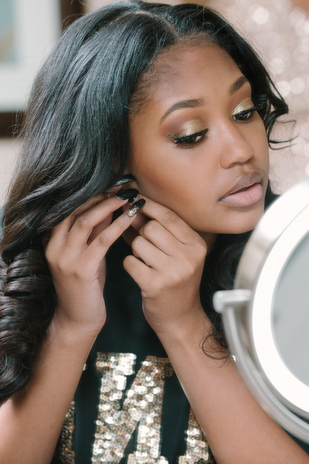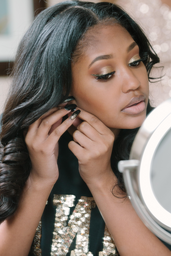The online beauty scene has come a long way in the last few years. The pre-pandemic beauty community and the post-pandemic beauty community are completely different. There has been a massive diversification in the makeup industry, with inclusivity at the forefront. This has all led to an increase in the amount of POC beauty creators, but they are still not typically mainstream. The improved access to POC-friendly makeup products has not correlated to better access to POC-friendly makeup content. Social media platforms, TikTok in particular, have become notorious for pushing POC content significantly less than Eurocentric content.
A Quick look at the algorithm
I searched the phrase “makeup tutorial” on YouTube with my watch history off and cleared. Scrolling through the first 27 videos, only three were POC, giving YouTube a ratio of one out of nine POC makeup tutorials. However, when I searched “easy makeup tutorial” instead, there was a much higher ratio of five out of nine.
TikTok was a bit trickier, as the algorithms are very heavily catered to the user. I sampled four accounts, one with an inactive user and three catered accounts. On the non-catered account after searching “makeup tutorial,” out of 26 videos, nine were people of color. For the sake of comparison, this is what I’m considering TikTok’s “default ratio,” so to speak. Each of the ratios on the catered accounts was different, ranging from five out of nine to three out of 10, but they were all greater than the default ratio.
It’s very common across social media platforms for POC to have to narrow the search down to specifics in order to find their features. Phrases like “Black girl makeup tutorial,” “Brown girl makeup tutorial,” and “Asian girl makeup tutorial” are super common keywords in the TikTok search bar. The search gets even harder when looking for specific visual aesthetics which are often seen as race-based despite that not being the case. It’s not unusual for inclusivity to take a hit the more aesthetically narrow the search is, as searching “goth makeup tutorial” will often offer less diversity than searching “makeup tutorial.” No matter what aesthetic you’re looking for, as a POC you’ll have to do some digging.
Where to start
When first starting your search, there are a few things you should keep in mind.
- Skin tone matches and facial feature matches don’t always go hand in hand.
Everyone’s face is unique and the odds of someone finding a creator that shares both their skin tone and their features are slim. So how do you decide which is most important? That depends entirely on what you’re looking for. If you really are starting from ground zero, it may be best to work out what products are right for you before getting into the best method of application. In this case, I would prioritize a skin tone match over a feature match. When it comes to finding contours, concealers, and blushes, color is the most important feature of the product. No need to search for your facial features here, once you’ve found a creator with a similar enough complexion take a look at the products they used and see if their shade match is close to yours. If you don’t find a perfect match, that’s okay! Odds are the brand the creator is using has a range of shades in that area. Finding a creator with a similar skin tone is fairly straightforward, as this can usually be done using keywords that apply to either your race or ethnicity and whatever aesthetic you’re looking for.
- Eyes are tricky.
Eye makeup is a little more complicated. Instead of being mainly color based over feature based, the two go hand in hand. Eyeshadow looks and different eyeliner techniques have a lot to do with both shape and color. For example, the same eye makeup on two people, one with hooded eyelids and one without, will look completely different simply because the eye shape has changed. In my opinion, it’s best to start with eye shape over skin tone. Once you have a general idea of what looks good on your eye shape, eyeshadow color is completely up to you. Most eyeshadows will show up the same color regardless of skin tone, but some problems may arise when it comes to how pigmented the colors are. Depending on your undertones and shade, some eyeshadows will show up better than others.
- Save, Like, Share
Once you find a creator that suits you, whether that be skin tone, facial structure, eye shape, or aesthetic, make sure you save the post. Make a playlist on YouTube, start a folder on Tiktok, save them on Instagram — whatever works best for you. There’s nothing more painful than the page refreshing after you stumble across the perfect post. To avoid this truly cataclysmic tragedy that at some point comes for us all, make sure you can come back to the post if you need to!
- The Benefits of Brands
Another method of finding makeup creators of color is searching by brand. Usually when an inclusive makeup line releases, there will be a wave of social media sponsorships. Fenty Beauty, for example, is known to have a wide variety of shades in all their products. Searching their brand on social media will allow you to see any sponsored content and increases the chances of you finding a creator with a similar skin tone. This is also great if you’re new to the products as sponsored tutorials usually come with a guide to application and an overall review of the quality.
Mix and match
It’s important to remember when looking for POC creators, it’s okay to mix and match with creators that don’t have your features. If you find a creator that isn’t a person of color but has your exact eye shape, use it! Finding a skin tone match for shopping, a facial feature match for application, and an eye shape match all in different places is how this process works for most people. While it is unfortunate that creators of color in the beauty industry have to be searched for, rather than just appearing in the regular stream of content, there has definitely been progress. With the increased reach of social media as of late, hopefully POC makeup artists will eventually rise into the mainstream. Until then I wish you all the best of luck in finding your features!


